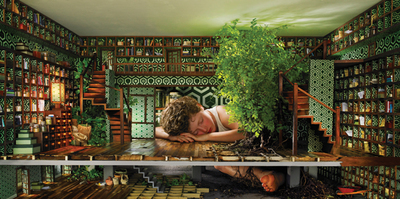LAETITIA SOULIER: THE FRACTAL ARCHITECTURES
The title, Laetitia Soulier: The Fractal Architectures, is a tongue twister, but the exhibit itself is pure pleasure. Soulier’s largescale color photographs offer imaginative worlds through repetitive symbols and patterns in built environments. In her photographs, interior rooms appear human-scale, but the presence of a child there alters it to Lilliputian-size. As the inaugural show for the Hood Downtown (which will be open while the Hood Museum undergoes a three-year renovation and addition), it makes a splash. It is challenging and breathtaking.

Laetitia Soulier, The Square Roots 2, from the series The Fractal Architectures, 2014, C-print. Courtesy of Claire Oliver Gallery and the artist. © Laetitia Soulier.
A fractal is defined as a natural phenomenon or mathematical set that exhibits a repeating pattern that stays largely the same at any scale. It’s sometimes referred to as expanding symmetry, which helps explain the interest an artist—and her audience—might take in it. The Matryoshka Dolls and The Square Roots are two subseries on exhibit. Soulier used graphic patterns of Matryoshka dolls (also known as Russian nesting dolls), based on fractals, which repeat everywhere from wallpaper to baby carriages.
Soulier acts as architect, set designer, carpenter, furniture maker and fabricator. She creates a scale model of the scene she envisions, then makes all the furnishings, as well as stairs, windows and doors. She photographs the completed set. To create a series, Soulier makes a separate model for each photographic setup, rebuilding walls and floors for each image. Final post-production work is done on her computer.
Soulier also created architectural models for the exhibit. Although they appear to be the sets Soulier photographed, they are unique 3-D constructions that make use of the same materials and some set pieces. The Matryoshka 3-D model has peepholes that invite observation. They are equally exciting as the photographs because they provide insight into her process.
What the eye sees in Soulier’s photographs poses a challenge to the brain: solve the mystery. The solution could destroy the magic which is fragile, beautiful and complex but, more likely it will lead to an exciting understanding of the intersection of art and science, where both are enhanced by the connection.
